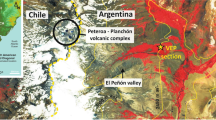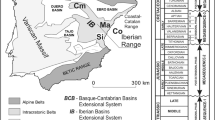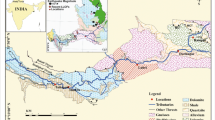Abstract
In arid central-west Argentina, South America, many wetlands have developed in association with rivers draining the Andean piedmont and are vital hotspots for resources. However, knowledge about their long-term evolution is generally scarce. The Bañados del Atuel wetland, a low gradient fluvio-aeolian plain linked to the Atuel-Diamante fluvial system, is analyzed to depict its geomorphological and sedimentological Holocene evolution. The study area comprises a fluvial fill terrace with fine-grained alluvial deposits (~ 4186–4419 cal years BP), deposited by a palaeodistributary fluvial system, that is covered by SW–NE oriented aeolian dune complexes. The present-day wetland, which developed after formation of the fill terrace, is characterized by: (1) a NW–SE oriented floodplain with distributary channels and fine-grained, massive to laminated deposits of low organic matter content, dated to 2755–2864 and 729–895 cal years BP, and includes SW–NE oriented dune systems and salt flat depressions; and (2) a transfer area with active headcutting channels, entrenched in the fill terrace, that connects the NW–SE oriented floodplain with (3) a saline endorheic depression (salt lake) with active deflation. The fill terrace distribution suggests much more extensive floodplain environments prior to the late Holocene; the present-day wetland is not older than the last 2–3 millennia and records a late Holocene trend of floodplain size reduction. Fluvial processes of avulsion were likely driven by mid and late Holocene El Niño Southern Oscillation (ENSO) events. Late Holocene arid conditions favoured aeolian dune formation and fluvio-aeolian interactions. Furthermore, anthropogenic river modifications, starting ~ 200 years ago, also have promoted severe changes in the Atuel-Diamante fluvial system, deepening the aridity in the wetland.




© image captures)






Similar content being viewed by others
Data availability
The datasets used and/or analysed during the current study are available from the corresponding author on reasonable request.
Code availability
Not applicable.
References
Aceituno P, Prieto MR, Solari ME, Martinez A, Poveda G, Falvey M (2009) The 1877–1878 El Niño episode: associated impacts in South America. Clim Change 92:389–416. https://doi.org/10.1007/s10584-008-9470-5
Araneo DC, Compagnucci RH (2008) Atmospheric circulation features associated to Argentinean Andean rivers discharge variability. Geophys Res Lett 35:L01805. https://doi.org/10.1029/2007GL032427
Araneo D, Villalba R (2015) Variability in the annual cycle of the Rio Atuel streamflows and its relationship with tropospheric circulation. Int J Climatol. https://doi.org/10.1002/joc.4185
Barchyn TE, Hugenholtz CH (2012a) Predicting vegetation-stabilized dune field morphology. Geophys Res Lett 39:L17403. https://doi.org/10.1029/2012GL052905
Barchyn TE, Hugenholtz CH (2012b) A process-based hypothesis for the barchan–parabolic transformation and implications for dune activity modelling. Earth Surf Proc Land. https://doi.org/10.1002/esp.3307
Benzaquén L, Blanco DE, Bo R, Kandus P, Lingua G, Minotti P, Quintana R (eds) (2017) Regiones de Humedales de la Argentina. Ministerio de Ambiente y Desarrollo Sustentable, Fundación Humedales / Wetlands International, Universidad Nacional de San Martín y Universidad de Buenos Aires, p 333. ISBN: 978-987-29811-6-7
Bull WB (1990) Stream-terrace genesis: implications for soil development. Geomorphology 3:351–367
Bullard JE, McTainsh GH (2003) Aeolian–fluvial interactions in dryland environments: examples, concepts and Australia case study. Prog Phys Geogr 27(4):471–501
Cano E (2004) Inventario Integrado de los Recursos Naturales de la provincia de La Pampa, 2° edición. Instituto Nacional de Tecnológica Agropecuaria – Universidad Nacional de La Pampa (Coord., 493 pp)
Cazenave HW (1979) Sobre algunos fluviogeónimos del área de los ríos Atuel ‐ Salado ‐ Chadileuvú. Administración Provincial del Agua. Gobierno de La Pampa. Unpublished report RA/0037
Criado Roqué P, Ibañez G (1979) Provincia geológica sanrafaelino-Pampeana. In: Turner JCM (ed) Segundo Simposio de Geología Regional Argentina. Academia Nacional de Ciencias, Córdoba, pp 837–869
Difrieri HA (1980) Historia del Río Atuel. Facultad de Filosofía y Letras, Universidad de Buenos Aires
Dornes PF, Buss RG, Secco ND (2013) Influencia de la intermitencia de los escurrimientos en la Cuenca inferior del río Atuel sobre la interacción agua superficial y subterránea. XXIV Congreso Nacional del Agua. San Juan. Argentina. Anales Congreso, 271. ISSN 1853-7685
Dornes PF, Antonena SV, Minig A, Comas RN, Schulz CJ, Mariño EE (2016) Relación entre regímenes de escurrimiento superficiales y subterraneos en los humedales de los ríos Atuel y Salado, La Pampa. In: Rel. Agua Subt.-Sup. García R, Rocha V, Dornes P (Eds), pp. 221–228. IX Cong. Arg. Hidrogeología - VII Sem. Hisp. Latinoamer. Hidrol. Subt. Catamarca. Arg. ISBN: 978-987-661-225-8
Folk RL, Andrews PB, Lewis DW (1970) Detrital sedimentary rock classification and nomenclature for use in New Zealand. N Z J Geol Geophys 13:937–968
Gil A, Zárate M, Neme G (2005) Mid-Holocene paleoenvironments and the archaeological record of Southern Mendoza, Argentina. Quat Int 132:81–94
Goudie A (2011) Parabolic Dunes: distribution, form, morphology and change. Ann Arid Zone 50(3–4):1–7
Grimm AM, Tedeschi RG (2009) ENSO and Extreme Rainfall Events in South America. J Clim 22:1589–1609. https://doi.org/10.1175/2008JCLI2429.1
Heiri O, Lotter AF, Lemcke G (2001) Loss on ignition as a method for estimating organic and carbonate content in sediments: reproducibility and comparability of results. J Paleolimnol 25:101–110
Hogg A, Heaton T, Hua Q, Palmer J, Turney C, Southon J et al (2020) SHCal20 southern hemisphere calibration, 0–55,000 years cal BP. Radiocarbon 62(4):759–778. https://doi.org/10.1017/RDC.2020.59
Jorgetti T, Silva Dias PL, Braconnot P (2006) Review of: El Niño influence over South America during the mid-Holocene. Adv Geosci 6:279–282
Junk WJ, An S, Finlayson CM, Gopal B, Kvet J, Mitchell SA, Mitsch WJ, Robarts RD (2013) Current state of knowledge regarding the world’s wetlands and their future under global climate change: a synthesis. Aquat Sci 75(1):151–167. https://doi.org/10.1007/s00027-012-0278-z
Karamperidou C, Di Nezio PN, Timmermann A, Jin F-F, Cobb KM (2015) The response of ENSO flavors to mid-Holocene climate: implications for proxy interpretation. Paleoceanography 30:527–547. https://doi.org/10.1002/2014PA002742
Lamy F, Kilian R, Arz HW, Francois J-P, Kaiser J, Prange P, Steinke T (2010) Holocene changes in the position and intensity of the southern westerly. Nat Geosci. https://doi.org/10.1038/NGEO959
Lorenzo FR (2019) Evolución Geológica de la cuenca inferior del río Atuel durante el Holoceno provincia de Mendoza y La Pampa). PhD thesis. Universidad Nacional de San Luis, San Luis, Argentina
Malvárez AI (1999) Tópicos sobre humedales subtropicales y templados de Sudamérica. Oficina Regional de Ciencia y Técnica para América Latina y el Caribe. Programa Hombre y Biosfera-Organización de las Naciones Unidas para la Educación, la Ciencia y la Cultura, pp. 228. ISBN 92-9089-064-9
Markgraf V (1983) Late and postglacial vegetational and paleoclimatic changes in subantarctic, temperate and arid environments in Argentina. Palynology 7:43–70. https://doi.org/10.1080/01916122.1983.9989252
Mehl AE, Zárate MA (2012) Late Quaternary alluvial records and environmental conditions in the eastern Andean piedmont of Mendoza (33º–34º S) Argentina. J S Am Earth Sci 37:41–59. https://doi.org/10.1016/j.jsames.2012.01.003
Melchor RN, Casadío S (2000) Hoja 3766-III La Reforma. Programa Nacional de Cartas Geológicas 1:250.000, Provincia de La Pampa. Servicio Geológico Minero Argentino, Boletín 295:1–56
Melchor RN, Llambías EJ (2004) Hoja Geológica 3766-I, Santa Isabel, Provincia de La Pampa. Programa Nacional de Cartas Geológicas 1:250.000 Secretaría de Minería de la Nación, Servicio Geológico Minero Argentino, Boletín N° 344. Buenos Aires
Novello VF, Cruz FW, Vuille M, Stríkis NM, Edwards RL, Cheng H, Emerick S, de Paula MS, Li X, Barreto E, Karmann I, Santos RV (2017) A high-resolution history of the South American Monsoon from Last Glacial Maximum to the Holocene. Sci Rep 7:44267. https://doi.org/10.1038/srep44267
Ortlieb L, Macharé J (1993) Former El Niño events: records from western South America. Global Planet Change 7:181–202
Razik S, Chiessi CM, Romero OE, von Dobeneck T (2013) Interaction of the South American Monsoon System and the Southern Westerly Wind Belt during the last 14 kyr. Palaeogeogr Palaeoclimatol Palaeoecol 374:28–40. https://doi.org/10.1016/j.palaeo.2012.12.022
Tooth S (2000) Process, form and change in dryland rivers: a review of recent research. Earth Sci Rev 51:67–107
Tooth S, McCarthy TS (2007) Wetlands in drylands: geomorphological and sedimentological characteristics, with emphasis on examples from southern Africa. Prog Phys Geogr 31(1):3–41
Tooth S, Nanson GC (2011) Distinctiveness and diversity of arid zone river systems. In: Thomas DSG (ed) Arid zone geomorphology: process, form and change in drylands, 3º. Wiley-Blackwell, Chichester, pp 269–300
Tooth S, Ellery F, Grenfell M, Thomas A, Kotze D, Ralph T (2015a) 10 reasons why the Geomorphology of wetlands is important. Wetlands in Drylands Research Network. http://wetlandsindrylands.net/wp-content/uploads/2015a/10/10-Reasons-Geomorphology-of-Wetlands-NEAR-FINAL-PRINTER-FRIENDLY.pdf.
Tooth S, Grenfell M, Thomas A, Ellery W (2015b) Wetlands in Drylands: ‘Hotspots’ of Ecosystem Service Provision in Marginal Environments. Science Brief for the United Nation’s Global Sustainable Development Report (GSDR)—2015b Edition. https://sustainabledevelopment.un.org/content/documents/640493-Tooth-Wetlands%20in%20Drylands_Hotspots%20of%20Ecosystem%20Services%20in%20Marginal%20Environments.pdf
Torres E, Zambrano J (2000) Hidrogeología de la Provincia de Mendoza. En: Argentina. Recursos y Problemas Ambientales de las Zonas Áridas. Primera Parte: Provincias de Mendoza, San Juan y La Rioja. Tomo I: Caracterización Ambiental
Tripaldi A, Forman SL (2007) Geomorphology and chronology of Late Quaternary dune fields of western Argentina. Palaeogeogr Palaeoclimatol Palaeoecol 251:300–320. https://doi.org/10.1016/j.palaeo.2007.04.007
Tripaldi A, Zárate M (2017) Geoformas eólicas de la cuenca del Río Salado-Chadileuvú, Provincia de La Pampa, Argentina. XX Congreso Geológico Argentino, San Miguel de Tucumán, Argentina
Tripaldi A, Zárate MA, Brook GA, Li GQ (2011) Late Quaternary paleoenvironments and paleoclimatic conditions in the distal Andean piedmont, southern Mendoza. Argentina Quat Res 76:253–263. https://doi.org/10.1016/j.yqres.2011.06.008
Tucker ME (2003) Sedimentary rocks in the field, 3rd ed. The Geological Field Guide Series. Chichester: Wiley
Universidad Nacional de La Pampa (Unlpam), Facultad Ciencias Exactas y Naturales (2012) Línea de base biótica, hidrológica y productiva. Estudio para la cuantificación monetaria del daño causado a la provincia de La Pampa por la carencia de un caudal fluvio ecológico del río Atuel. Volume II (2)
Urbiztondo AM (1974) Fotointerpretación del área de los ríos Salado y Atuel (con cartografía reducida) desde el paralelo 35º 45’ al paralelo 38º a escala 1:50.000. Consejo Provincial del Agua de La Pampa. 21 pp. Santa Rosa. Unpublished.
Wittmann F, Householder E, de Oliveira WA, Lopes A, Junk WJ, Piedade MTF (2015) Implementation of the Ramsar Convention on South American wetlands: an update. Res Rep Biodivers Stud 4:47–58. https://doi.org/10.2147/RRBS.S64502
Zárate MA, Mehl A (2011) Evolución geomorfológica holocena de la cuenca media del río Atuel, Mendoza, Argentina. XVIII Congreso Geológico Argentino. Neuquén, Argentina
Zárate M, Urrutia J, Lanzillotta R, Mehl A (2005) Estudio para la determinación del caudal mínimo necesario para el restablecimiento del sistema ecológico fluvial en el curso inferior del río Atuel. Capítulo 6: características geomorfológicas y sedimento-pedológicas. Universidad Nacional de La Pampa
Zárate MA, Dornes PF, Mehl A, Tripaldi A, Lorenzo F (2018) Bañados del Atuel (provincia de La Pampa, Argentina): de humedal a desierto, ¿un camino sin retorno? VII Congreso Argentino de Cuaternario y Geomorfología. Puerto Madryn, Argentina. Abstracts book
Acknowledgements
Dr. Florencia Lorenzo’s studies were part of a PhD thesis research carried out with a grant of the National Research Council of Argentina (CONICET). We gratefully acknowledge Dr. Adriana Blasi (FCEyN - UNLP) for an early reading of the manuscript. Our gratitude is extended to the two anonymous reviewers, the Editor-in-Chief and the Guest Editor (Professor Stephen Tooth) for their suggestions and comments that improved and strengthened the manuscript.
Funding
This work was funded by PICT 2012-1512 and PICT 2018-02465 from the ANPCyT, and PIO-12CO from CONICET-UNLPam.
Author information
Authors and Affiliations
Contributions
All authors contributed to the conceptualization of the study and its design, field work and the formal analysis and interpretation of data. AEM: funding acquisition; investigation; first manuscript draft; visualization; manuscript writing, reviewing and editing. MAZ: funding acquisition; investigation; supervision; manuscript writing; review. FRL: investigation; GIS software management; review.
Corresponding author
Ethics declarations
Conflict of interest
The authors have no conflicts of interest to declare that are relevant to the content of this manuscript.
Ethical approval
Not applicable.
Consent to participate
Not applicable.
Consent for publication
Not applicable.
Additional information
Publisher's Note
Springer Nature remains neutral with regard to jurisdictional claims in published maps and institutional affiliations.
Rights and permissions
About this article
Cite this article
Mehl, A.E., Zárate, M.A. & Lorenzo, F.R. Holocene evolution of a floodplain wetland in the dryland piedmont of central-west Argentina. Wetlands Ecol Manage 30, 647–673 (2022). https://doi.org/10.1007/s11273-022-09880-6
Received:
Accepted:
Published:
Issue Date:
DOI: https://doi.org/10.1007/s11273-022-09880-6




